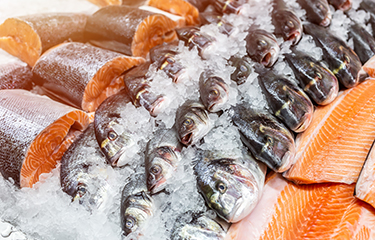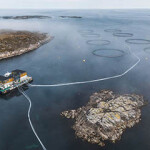Norway sees high seafood export value buoyed by weak krone and strong demand

Norway saw high seafood export values in November as a weak kroner coupled with strong demand continued to see the country post big year-over-year increases.
According to data released by the Norwegian Seafood Council (NSC), Norway exported NOK 16.7 billion (USD 1.5 billion, EUR 1.4 billion) worth of seafood in the month of November, an increase of 17 percent over the NOK 14.4 billion (USD 1.3 billion, EUR 1.2 billion) the country exported in November 2022. For the year, the country has so far exported NOK 158.2 billion (USD 14.4 billion, EUR 13.4 billion) worth of seafood in 2023, a 15 percent increase over 2022.
“On 13 November, seafood exports surpassed the 2022 full-year export total of NOK 151.4 billion [USD 13.8 billion, EUR 12.8 billion],” Norwegian Seafood Council CEO Christian Chramer said in a release. “This year, we expect the value of Norwegian seafood exports will exceed NOK 170 billion [USD 15.5 billion, EUR 14.4 billion], for which we can largely thank the weak Norwegian krone.”
With the weaker krone taken into account, Norway’s November export value in 2023 is on par with 2022. Norway’s NOK 14.4 billion in exports was worth USD 1.5 billion and EUR 1.4 billion in 2022, meaning its export value in November 2023 is roughly equal to 2022 in terms of the U.S. dollar and the Euro.
“The export value so far this year is approximately NOK 20 billion (USD 1.8 billion, EUR 1.7 billion) higher than at the same time last year. Almost two-thirds of this increase in value can be attributed to a weaker Norwegian krone,” Chramer said. “The euro, which is our most important trading currency, has strengthened by 14 percent against the Norwegian krone in the past year.”
All told, Norway exported 274,200 metric tons (MT) of seafood. The strongest markets in the month, NSC said, were Poland, Denmark, and the U.S. Poland took in an additional NOK 561 million (USD 51 million, EUR 47 million) worth of Norwegian seafood, an increase in value of 36 percent year over year. In volume terms, the country imported 31,619 MT of Norwegian seafood, an increase of 3 percent year over year.
The weaker krone has helped Norway’s export value figures, but the high demand for salmon, mackerel, and trout have also played a part.
The country exported 128,324 metric tons (MT) of salmon in November, worth NOK 11.7 billion (USD 1.07 billion, EUR 992 million) – an increase of 3 percent in volume and 18 percent in value over last year.
“November was a particularly good month for salmon. Increased volume and higher prices compared to the same period last year prove that there is an increase in demand in the market,” Chramer said.
The increase in volume sold, NSC added, came even as prices increased.
“Price increases at the same time as volume growth show that there is still growth in demand for salmon, compared to the same period last year,” NSC Seafood Analyst Paul T. Aandahl said.
Mackerel exports reached NOK 1.1 billion (USD 100 million, EUR 93 million) in value in November, an increase of NOK 513 million (USD 47 million, EUR 43 million), or 86 percent, compared to last year. That increase in value was aided by a 57 percent increase in volume to 48,488 MT. South Korea, China, and Japan were the biggest markets for the species, NSC said.
For the year, mackerel exports have lagged behind 2022, NSC Manager for Pelagic Species Jan Eirik Johnsen said.
“Although total exports are about 30,000 [MT] (9.2 percent) behind last year due to lower quota and catch, direct exports to Japan have increased by over 10,000 [MT], and South Korea is on par with last year,” he said.
All told, 67 percent of Norway’s mackerel exports have gone to Asia.
The value and volume of trout also increased year over year. Norway shipped 6,397 MT of trout worth NOK 561 million (USD 51 million, EUR 47 million), an increase in volume of 31 percent and an increase in value of 25 percent.
Ukraine became the largest export market for trout, seeing an increase in value of NOK 54 million (USD 4.9 million, EUR 4.5 million), or 171 percent, compared to the same month last year. The country imported 1,174 MT of trout in total, an increase of 148 percent.
“It is the first time since the war started that Ukraine is our biggest market for trout,” Aandahl said.
Exports of fresh cod continued to highlight the growth of farmed cod in Norway. The country’s exports of fresh cod declined in volume by 18 percent to 2,420 MT, and fell in value by NOK 36 million (USD 3.3 million, EUR 3 million) to NOK 141 million (USD 13 million, EUR 12 million), 20 percent lower than its export value in 2022.
While overall exports of fresh cod dropped – largely to a drop in catch – exports of farmed cod spiked.
“Farmed cod continues to increase in volume. With an export of 960 [MT] in November, the volume increased by a whopping 93 percent compared to last year,” NSC Seafood Analyst Eivind Hestvik Brækkan said. “With an export value of NOK 56 million [USD 5 million, 4.7 million], 39 percent of the export value of fresh cod in November was farmed cod.”
Frozen cod, meanwhile, had both volume and value increases. The country exported 5,150 MT of frozen cod worth NOK 269 million (USD 24.6 million, EUR 22.8 million), an increase of 28 percent and 13 percent, respectively.
One key highlight in Norway’s frozen cod exports is a big decrease in the amount the country is sending to China. Only 18 percent of the export value of frozen cod has come from China so far in 2023, the lowest proportion of the value since 2009.
Vietnam, meanwhile, is moving in the opposite direction of China.
“Vietnam stands out as a large growth market, with as much as 7 percent of the export value this year, which is the highest ever,” Brækkan said. “Vietnam is mainly a further processing country for frozen cod that processes and re-exports most of it to Europe and the U.S.A.”
The vast majority of frozen cod went to the U.K., which NSC said is “consolidating its position as our largest market.” Year to date the U.K. has provided 29 percent of all the export value of frozen cod.
“This is as expected after the UK introduced increased export tariffs on imports of Russian whitefish last summer,” Brækkan.
Not every species saw increases in November. Norway’s exports of herring for the month were weak, with the country exporting 25,950 MT worth NOK 492 million (USD 45 million, EUR 41 million) – a drop of 42 percent and 16 percent, respectively. The main culprit is lower catch.
“So far this year, 14 percent less NVG herring [Norwegian spring-spawning herring] have been landed, which reflects the quota reduction of 15 percent compared to last year,” Johnsen said.
Despite the lower volume total, there was, Johnsen said, a price record for the largest sizes of NVG herring – which come in frozen skinless fillets and frozen round product forms. The average price for skinless fillets reached NOK 20.27 (USD 1.85, EUR 1.71) per kilogram.
“This is 38 per cent and 21 per cent higher than the corresponding prices in November last year, respectively,” Johnsen said. “Good demand in important fillet markets, lower catches this autumn, and a sharp cut in the quota for next year will send the prices of several products upwards.”
Photo courtesy of Gorlov-KV/Shutterstock






Share